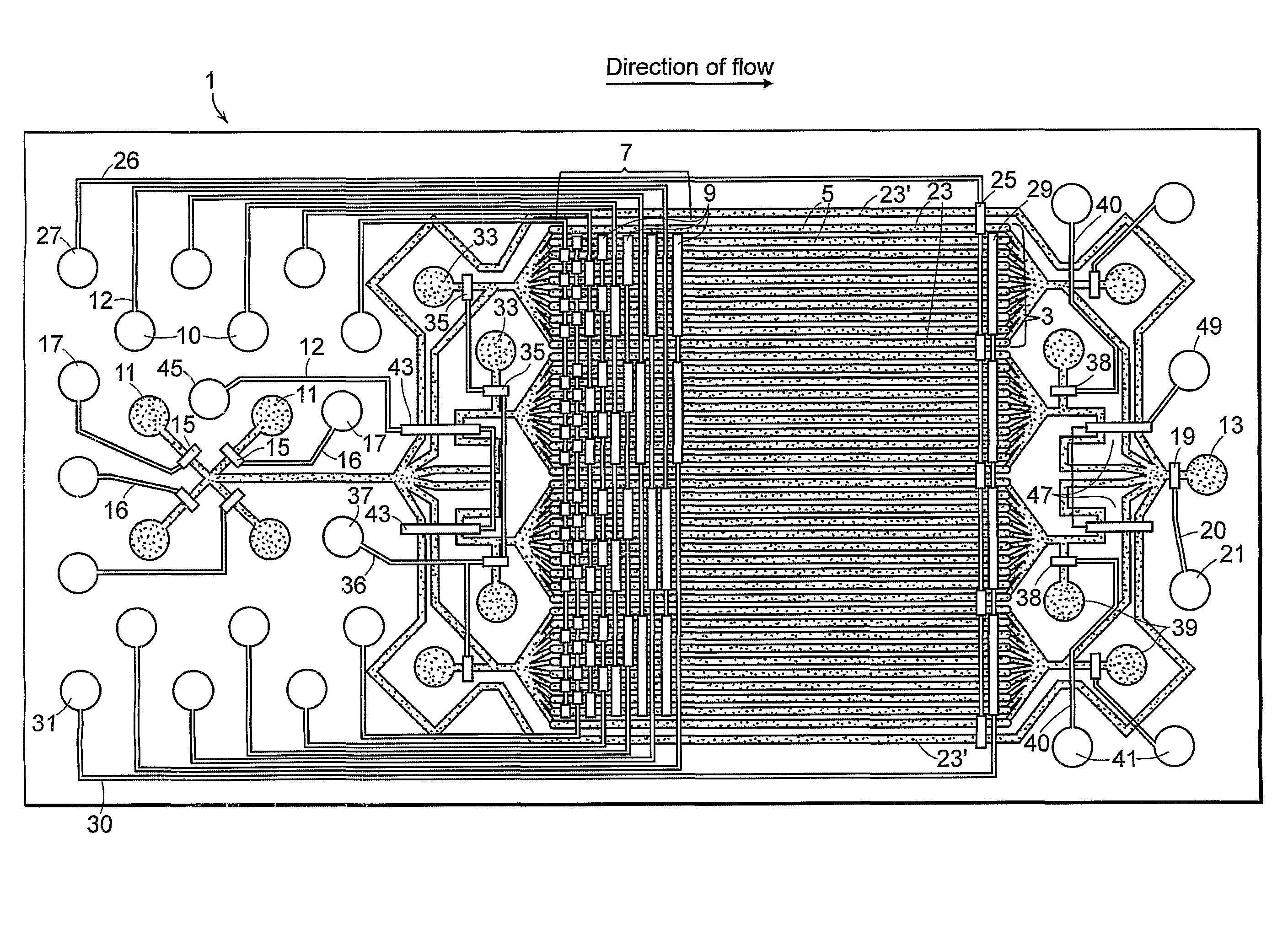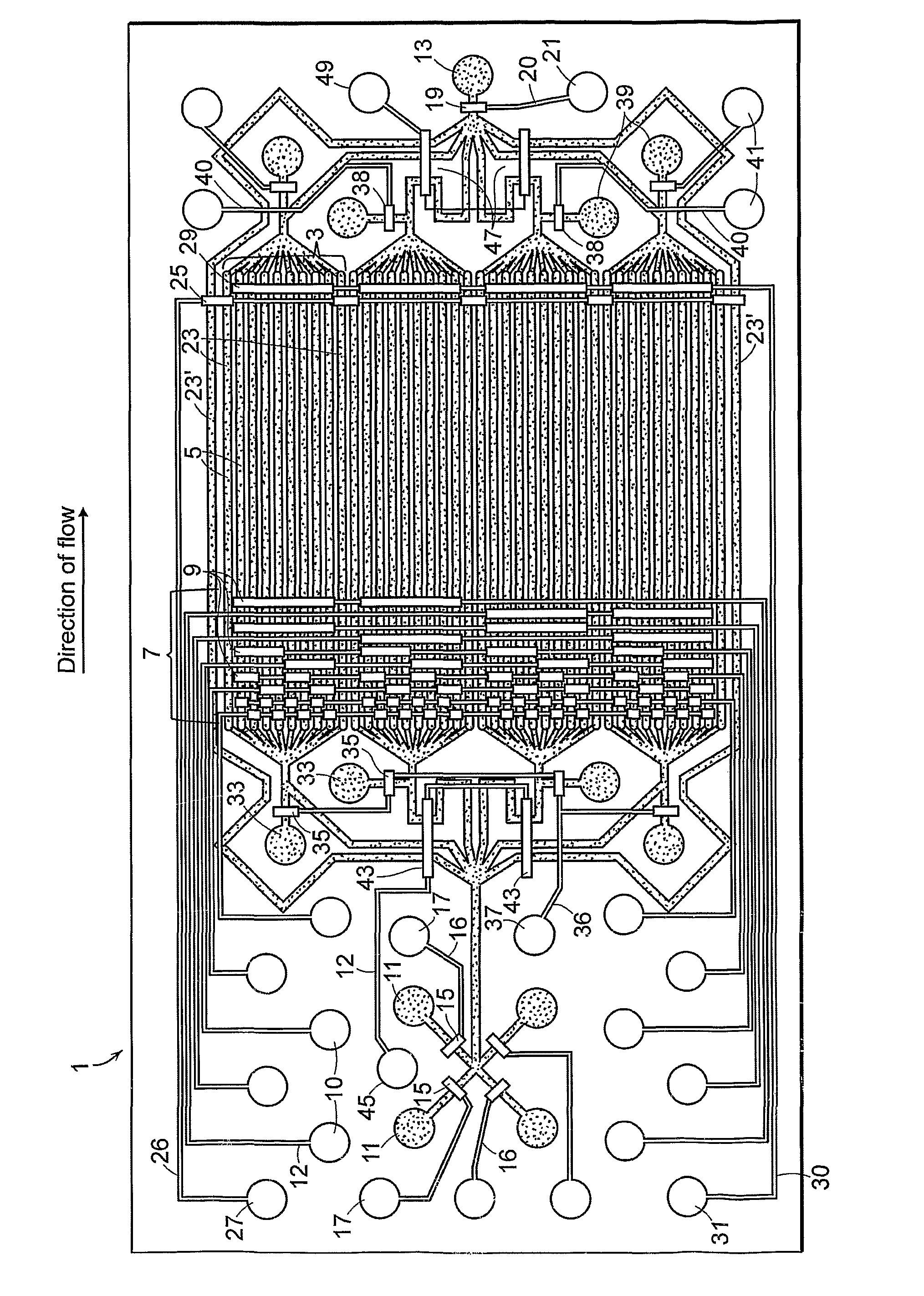Device for high-throughput stimulation, immunostaining, and visualization of single cells
a single cell, high-throughput technology, applied in the field of microfluidic devices, can solve the problems of low throughput, laborious cell assays, low throughput, and need for a large volume of reagents, and achieve the effect of improving the sealing of the fluid channel
- Summary
- Abstract
- Description
- Claims
- Application Information
AI Technical Summary
Benefits of technology
Problems solved by technology
Method used
Image
Examples
example 1
Fabrication of a Device for High-Throughput Stimulation, Immunostaining and Visualization of a Single Cell
[0043]The device was made using standard soft lithography techniques. The method of fabrication of the device is not a limitation of the invention.
[0044]Elastomeric devices have been developed for use in biological studies (for review see Sia and Whitesides 2003. Electrophoresis 24:3563-3576). Such devices are can be biocompatible and can be prepared relatively easily and inexpensively by methods well known to those skilled in the art (See e.g., reviews Whitesides et al., 2001. Ann. Rev. Biomed. Eng. 3:335-373, incorporated herein by reference). Elastomeric devices made by the process of soft lithography are produced by casting of polydimethylsulfoxide (PDMS) or other silicone rubber onto micromachined molds or coated silicone wafers patterned using contact lithography; however, other materials and methods can be used.
[0045]Briefly, for fabrication of the device of FIG. 1, the f...
example 2
Cell Culture, Stimulation, and Immunofluorescence Staining
[0049]The device was fabricated as described in Example 1. The device was filled with sterile 0.1% gelatin with all of the valves open through an inlet port 11 to coat the parallel fluid channels to promote cell adhesion. Valves were primed with filtered, distilled water. Alternatively, filling may be done with the ports closed as trapped air can be pushed out of the gas-permeable PDMS with hydrostatic pressure. The device was flushed with to remove the coating agent. Well-separated NIH3T3 mouse fibroblasts at a concentration of about 9 million cells per ml were introduced into the parallel fluid channels through an inlet port and the device was transferred to a standard 5% CO2, 37° C. cell culture incubator for 3-4 hours to allow the cells to adhere to the glass bottom of the parallel fluid channels. Cells were observed at various time points after seeding and were found to be viable and have normal morphology for at least 1...
example 3
Detailed 32-Point Timecourse of the Response of One or More Proteins to Persistently Applied Stimulus or Drug
[0052]The method is most readily accomplished using a device having four reaction units with eight parallel fluid channels per reaction unit such as the device shown in FIG. 1. A device can be readily fabricated to allow for variation in the number of reaction units and parallel fluid channels. The device was flushed with DPBS before each step to remove the chemical agent form the preceding step.
[0053]The device was coated the device with an agent that promotes cell adherence (e.g. gelatin, poly L-lysine, fibronectin, collagen, etc.). Cells were introduced into the device and allowed to adhere. Unattached cells were removed by flushing the parallel fluid channels with media. Valves were primed with filtered distilled water and flow is shut off all channels. Media containing an active agent was introduced into the device via any of the main inlets. The multiplexer was actuated...
PUM
| Property | Measurement | Unit |
|---|---|---|
| length | aaaaa | aaaaa |
| length | aaaaa | aaaaa |
| width | aaaaa | aaaaa |
Abstract
Description
Claims
Application Information
 Login to View More
Login to View More - R&D
- Intellectual Property
- Life Sciences
- Materials
- Tech Scout
- Unparalleled Data Quality
- Higher Quality Content
- 60% Fewer Hallucinations
Browse by: Latest US Patents, China's latest patents, Technical Efficacy Thesaurus, Application Domain, Technology Topic, Popular Technical Reports.
© 2025 PatSnap. All rights reserved.Legal|Privacy policy|Modern Slavery Act Transparency Statement|Sitemap|About US| Contact US: help@patsnap.com


